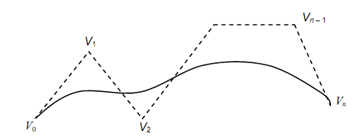Bezier Curves:
Bezier curves are utilized in CAD and are named after a mathematician working in the automotive industry. These are based on approximation techniques that generate curves that do not pass through all of the given data points except the first & the last control point. A Bezier curve does not needs first-order derivative; the shape of the curve is controlled by control points.
For n + 1 control points, the Bezier curve is described by a polynomial of degree n as follows :
 ------------ (1)
------------ (1)
where V (t) is the position vector of a point on the curve segment and Bi, n are the Bernstein polynomials, that serve as the blending or basis function for the Bezier curve.
The Bernstein polynomial is described as
Bi, n (t ) = C (n, i) t i (1 - t )n - i = (n!/ ( i! (n - i)! ) ) ti (1 - t )n - i --------- (2)
where C (n, i) is the binomial coefficient specified by
C (n, i) = n! / ( i! (n - i)!) ----------- (3)
Substituting Eq. (2) in Eq. (1)

Here V0, V1, . . . , Vn are the position vectors of n + 1 points that form the so-called characteristic polygon of the curve segment.

Figure: Bezier Curve and its Characteristic Polygon